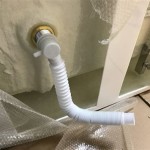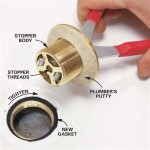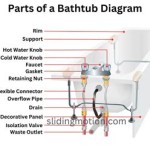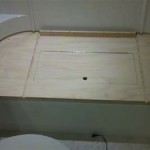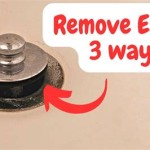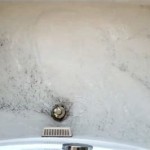What Is An Overflow Plate In A Bathtub?
The overflow plate in a bathtub is a seemingly small, often overlooked component, yet it plays a vital role in the functionality and safety of the fixture. Its primary function is to prevent water from overflowing the bathtub, thereby mitigating potential water damage to the bathroom and surrounding areas. This article delves into the details of the overflow plate, exploring its purpose, components, different types, troubleshooting common issues, and emphasizing its importance in plumbing systems.
The overflow plate is typically a circular or rectangular metal or plastic plate located near the top of the bathtub, usually beneath the faucet and above the drain. It is not merely decorative; it is a critical part of a system designed to manage water levels. Recognizing its function and understanding its mechanics is essential for homeowners and maintenance professionals alike.
Understanding the Purpose of the Overflow Plate
The fundamental purpose of the bathtub overflow plate is to provide an escape route for water once it reaches a certain level. Without an overflow mechanism, the risk of water spilling onto the bathroom floor is significantly increased. This spillage can lead to a host of problems, including damage to flooring, walls, and even structural components of the building, as well as promoting mold and mildew growth.
The overflow plate is connected to a drainpipe, often hidden behind the bathroom wall. When the water level in the bathtub rises to the level of the overflow plate, the excess water flows into this drainpipe and is directed to the main drain system. This prevents the bathtub from overflowing, protecting the surrounding areas from water damage. The overflow mechanism acts as a safeguard, allowing the user to fill the tub to a comfortable level without the constant worry of overfilling.
Furthermore, the overflow plate can also offer a secondary function. In some bathtub designs, the overflow drain can act as a vent, allowing air to escape from the drainpipe system as the bathtub is being filled. This venting action contributes to a smoother and faster filling process, preventing airlocks that can slow down the draining of water later. This ancillary function adds to the overall efficiency of the bathtub drainage system.
Components of an Overflow System
The overflow system isn't just the visible plate; it's a connected assembly of parts working in conjunction. Key components include the overflow plate itself, the overflow drain tube, the connecting flange, and various seals and gaskets.
The overflow plate, as mentioned before, is the visible component. This plate usually has a hole or a series of holes that allow water to enter the overflow drain. The design can vary slightly depending on the bathtub model and aesthetic preference, but the core function remains the same.
The overflow drain tube is the pipe that connects the overflow plate to the main drainpipe. This tube is typically made of PVC or brass and is strategically angled to facilitate the flow of water. The length and diameter of the tube are crucial for efficient water drainage. Any obstructions or blockages within this tube can compromise the entire overflow system's functionality.
The connecting flange is the fitting that joins the overflow plate to the overflow drain tube. This flange is often secured with screws and a rubber gasket to create a watertight seal. Proper installation and maintenance of this flange are essential to prevent leaks behind the bathtub wall. Ensuring the screws are neither too tight nor too loose is important to maintain the integrity of the seal and the plate itself.
Seals and gaskets are critical for ensuring a watertight connection between all the components. These are typically made of rubber or silicone and are placed between the overflow plate, the flange, and the bathtub surface. Regular inspection and replacement of these seals are vital to prevent leaks and maintain the system's efficiency over time. Deteriorated or cracked seals can lead to slow leaks that can cause significant damage if left unaddressed.
Types of Overflow Plates and Mechanisms
While the basic function remains consistent, variations exist in the design and operation of overflow plates and their associated mechanisms. These variations largely depend on the bathtub model, its age, and the manufacturer's design choices. Understanding these differences is crucial for proper maintenance and repair.
One common type is the standard open-hole overflow plate. This design features one or more open holes in the plate, allowing water to freely enter the overflow drain. This type is generally simple to install and maintain. Clogs are usually easy to identify and remove, making it a popular choice for many bathtubs.
Another type is the trip-lever overflow plate. This design incorporates a lever or knob that controls a plunger or stopper within the drainpipe. When the lever is in the "open" position, the plunger allows water to flow freely through the overflow drain. When the lever is in the "closed" position, the plunger seals the drain, preventing water from entering the overflow. This type of overflow is often integrated with the bathtub's drain stopper mechanism, providing a convenient way to control both the drain and overflow functions. Trip-lever mechanisms are more complex than simple open-hole designs and may require more intricate repairs.
A third type is the slotted overflow plate, which features elongated slots instead of open holes. These slots provide a wider surface area for water to enter the overflow drain, potentially increasing the system's efficiency in preventing overflows. The slotted design can also offer a more streamlined aesthetic. However, the slots can sometimes be more prone to collecting hair and debris compared to open holes, requiring more frequent cleaning.
Finally, some modern bathtubs incorporate minimalist or hidden overflow designs. In these designs, the overflow drain may be concealed behind a decorative panel or integrated seamlessly into the bathtub's structure. While these designs can offer a more aesthetically pleasing appearance, they can also be more challenging to access for maintenance and repairs. The hidden nature of the components means that potential problems might go unnoticed for longer, leading to more extensive damage.
Troubleshooting Common Overflow Plate Issues
Several common issues can arise with bathtub overflow plates and their associated mechanisms. Recognizing and addressing these issues promptly can prevent more significant plumbing problems and costly repairs.
One of the most common problems is a clogged overflow drain. Hair, soap scum, and other debris can accumulate in the overflow drainpipe, restricting the flow of water and potentially causing overflows. Signs of a clogged overflow drain include slow drainage of water from the bathtub, gurgling sounds coming from the drain, or water pooling around the overflow plate. To clear a clogged overflow drain, one can use a drain snake, a wet/dry vacuum, or a specialized drain cleaning solution. Prevention, through the use of drain screens or regular cleaning, is key in avoiding this issue.
Another issue is a leaking overflow plate. Leaks can occur due to deteriorated seals, loose connections, or damaged components. Signs of a leaking overflow plate include water stains on the wall behind the bathtub, dampness around the base of the bathtub, or a musty odor in the bathroom. To repair a leaking overflow plate, one may need to replace the seals or gaskets, tighten the connections, or replace damaged components. Identifying the source of the leak is crucial before attempting any repairs. Careful examination of all the components, including the flange and the drain tube, is necessary.
A malfunctioning trip-lever mechanism is another potential problem. The trip-lever mechanism can become stuck, broken, or misaligned, preventing it from properly opening or closing the overflow drain. Signs of a malfunctioning trip-lever mechanism include difficulty operating the lever, water leaking from the overflow drain even when the lever is in the "closed" position, or water not draining properly when the lever is in the "open" position. To repair a malfunctioning trip-lever mechanism, one may need to adjust the lever, replace worn parts, or lubricate the moving components. In some cases, it may be necessary to replace the entire trip-lever assembly.
Finally, damaged or corroded components can also cause problems. Over time, the metal or plastic components of the overflow system can become corroded, cracked, or otherwise damaged due to exposure to water, soap, and other chemicals. Signs of damaged components include visible cracks, rust, or deformation in the overflow plate, drain tube, or connecting flange. To address damaged components, they should be replaced with new, compatible parts. Regular inspection and maintenance can help identify and address potential issues before they escalate.
In conclusion, the overflow plate is an essential component of any bathtub, serving a critical role in preventing water damage. Understanding its purpose, components, types, and troubleshooting methods is crucial for maintaining a safe and functional bathroom. By proactively addressing potential issues and performing regular maintenance, homeowners can ensure the long-term performance and reliability of their bathtub's overflow system.

How To Install A New Bathtub Overflow Plate Assembly

What Is A Bathtub Overflow Drain 2025 Guide With Examples And Photos Badeloft

Diy Solutions For Your Problematic Bathtub Overflow Plate Eagle Mountain Woodford Watco Blog

How To Replace Bathtub Overflow Plate With Trip Lever Easy Simple

When And How You Should Replace A Bathtub Overflow Cover Plate Service Plus Plumbing

Drain Overflow Assemblies Fine Homebuilding

Danco Single Hole Bathtub Drain Overflow Plate In Brushed Nickel 89235 The Home Depot

Watco Two Hole Bathtub Overflow Plate Includes And In Chrome 18002 Cp The Home Depot

Here S The Best Way To Replace Your Tub Overflow Plate Eagle Mountain Woodford Watco Blog

Deep Water Bathtub Overflow Cover
Related Posts

